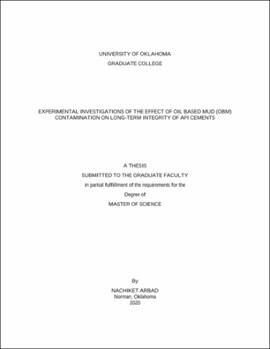| dc.contributor.advisor | Teodoriu, Catalin | |
| dc.contributor.author | Arbad, Nachiket | |
| dc.date.accessioned | 2020-12-01T20:54:53Z | |
| dc.date.available | 2020-12-01T20:54:53Z | |
| dc.date.issued | 2020-12 | |
| dc.identifier.uri | https://hdl.handle.net/11244/326569 | |
| dc.description.abstract | Well construction, well abandonment, and restoration of well integrity are the reasons at a broad level why cementing jobs are performed. During the well construction phase, the primary objective of the cementing job is to replace the drilling mud in the annulus with pure cement. Intermixing of the drilling mud and the cement slurry produces an unpumpable mixture, especially in the case of Oil-Based Mud (OBM). The displacement efficiency of spacers and pre-flushes used to displace the drilling mud is never 100%, thus cement slurries are contaminated with drilling mud. Recently, several research groups have performed studies to understand the strength development phenomenon of OBM contaminated cement slurries. A detailed review of these studies illustrates several shortcomings like variations in sample preparation, focus on the high amount of OBM contamination, lack of documentation of experimental procedures, focus on early curing time, and so on.
The primary aim of this study was to develop a standard laboratory experimental procedure for understanding the strength development of OBM contaminated cement slurries and develop a reliable dataset for future references. The study focused on the effect of low OBM contaminations ranging from 0.8% to 6.3% (by volume) on API Class C & H cement samples cured from a minimum of 4 hours to a maximum of 1 year at room temperature (25℃) and elevated temperature of 75℃. Destructive tests to measure the uniaxial compressive strength (UCS) and non-destructive tests to measure the ultrasonic pulse velocity (UPV) were performed on 362 contaminated as well as neat cement samples. Results obtained from these tests showed a detrimental effect on the strength of cement samples even with such low OBM contaminations. Correlations for predicting the long-term strength of OBM contaminated cement slurries were developed using the test results. These correlations developed would help the operators in better estimation of the strength developed by the OBM contaminated cement slurries. In other words, a more accurate prediction of cement wellbore integrity. | en_US |
| dc.language | en_US | en_US |
| dc.subject | Oil-Based Mud (OBM) | en_US |
| dc.subject | API Cements | en_US |
| dc.subject | Uniaxial Compressive Strength (UCS) | en_US |
| dc.subject | Ultrasonic Pulse Velocity (UPV) | en_US |
| dc.subject | Contamination | en_US |
| dc.title | Experimental investigations of the effect of oil based mud (OBM) contamination on long-term integrity of API cements | en_US |
| dc.contributor.committeeMember | Ahmed, Ramadan | |
| dc.contributor.committeeMember | Karami, Hamidreza | |
| dc.contributor.committeeMember | Amani, Mahmood | |
| dc.date.manuscript | 2020-11-26 | |
| dc.thesis.degree | Master of Science | en_US |
| ou.group | Mewbourne College of Earth and Energy::Mewbourne School of Petroleum and Geological Engineering | en_US |
| shareok.orcid | 0000-0002-1535-3656 | en_US |
